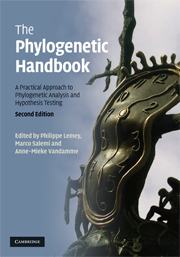Book contents
- Frontmatter
- Contents
- List of contributors
- Foreword
- Preface
- Section I Introduction
- Section II Data preparation
- Section III Phylogenetic inference
- Section IV Testing models and trees
- Section V Molecular adaptation
- Section VI Recombination
- 15 Introduction to recombination detection
- 16 Detecting and characterizing individual recombination events
- Section VII Population genetics
- Section VIII Additional topics
- Glossary
- References
- Index
16 - Detecting and characterizing individual recombination events
from Section VI - Recombination
Published online by Cambridge University Press: 05 June 2012
- Frontmatter
- Contents
- List of contributors
- Foreword
- Preface
- Section I Introduction
- Section II Data preparation
- Section III Phylogenetic inference
- Section IV Testing models and trees
- Section V Molecular adaptation
- Section VI Recombination
- 15 Introduction to recombination detection
- 16 Detecting and characterizing individual recombination events
- Section VII Population genetics
- Section VIII Additional topics
- Glossary
- References
- Index
Summary
THEORY
Introduction
In addition to point mutation, the most important mechanisms whereby organisms generate genomic diversity are undoubtedly nucleic acid recombination and chromosomal REASSORTMENT. Although this chapter will mostly deal with the characterization of true recombination events, many of the methods described here are also applicable to the detection and description of reassortment events. Moreover, we will focus on HOMOLOGOUS RECOMBINATION, which is defined as the exchange of nucleotide sequences from the same genome coordinates of different organisms. Although HETEROLOGOUS RECOMBINATION (i.e. recombination resulting in either the physical joining of segments in unrelated genes or gross insertion/deletion events) will not be considered, many of the methods described in this chapter may also be applicable to the detection and analysis of this form of genetic exchange.
Whereas the genomes of all cellular organisms and some viruses are encoded in DNA, many viruses use RNA as their genetic material. The importance of recombination in the evolution of life on earth is underlined by the fact that various mechanisms for both DNA and RNA genomic recombination have evolved. Well-studied recombination mechanisms mediating double-stranded DNA break repair and/or chromosomal recombination during meiotic cell division are extremely common amongst cellular organisms and it is believed that DNA viruses also access these mechanisms during nuclear replication within infected host cells.
Conversely, the recombination mechanisms used by RNA viruses and retroviruses (whose genomes pass intermittently through DNA and RNA phases), are generally encoded by the viruses themselves.
- Type
- Chapter
- Information
- The Phylogenetic HandbookA Practical Approach to Phylogenetic Analysis and Hypothesis Testing, pp. 519 - 548Publisher: Cambridge University PressPrint publication year: 2009
- 5
- Cited by

